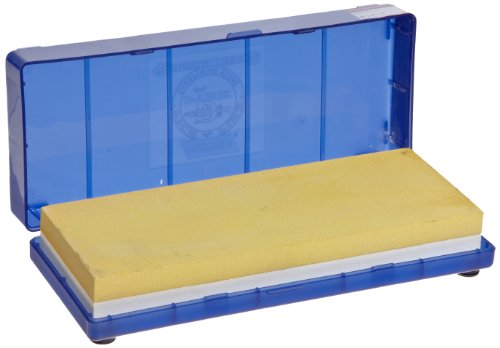!9# Norton 24336 Japanese-Style Combination Waterstone 4000/8000 Grit, 8-Inch by 3-Inch by 1-Inch
The Norton 24336 Japanese-style 4000/8000-grit combination waterstone creates an abrasive slurry for effective sharpening, with 4000 grit on one face for maintaining and refining a cutting edge, and 8000 grit on the opposite face for polishing cutting edges; this 1 x 8 x 3 inch (H x W x D) stone, suitable for bench use, cleans up easily with water, and comes encased in a blue plastic hinged box. (H is height, the vertical distance from lowest to highest point; W is width, the horizontal distance from left to right; D is depth, the horizontal distance from front to back.) The box protects the waterstone and provides a reservoir to keep it moist. The removable box lid, with no-slip rubber feet, acts as a sharpening station to hold the waterstone in place during bench use.
This synthetic waterstone is created by grading abrasive material to a consistent particle size and blending it with bonding agents. It is then molded and surface-finished. Waterstones have a finer grit and softer bond than oilstones, and use water as the lubricant to develop a slurry, a thin paste of abrasive grains and water that removes metal with less pressure than an oilstone requires. Cleanup is easier than with oil as lubricant. The use of waterstones originated in Japan, where such stones occur naturally. As a result, some synthetic waterstones may be called “Japanese-style.” However, whether natural or synthetic, and whether labeled “Japanese-style,” all waterstones have the same basic characteristics. This stone conforms to the Japanese Industrial Standard (JIS) for waterstones.
Sharpening stones, or whetstones, are abrasive surfaces used to sharpen and hone the edges of steel cutting implements such as chisels, knives, scissors, hand scrapers, and plane blades. Sharpening is the process of creating or re-establishing a cutting edge by grinding away portions of the metal to adjust the angle of the edge and reform the shape. Honing removes small imperfections. Stones can be flat, for working flat edges, or shaped, for edges that are more complex. Sharpening stones are made of natural or synthetic materials that range from softer to harder, and are categorized by the size of their abrasive particles, known as grit. A stone with a coarser grit is used when more metal needs to be removed (e.g., when sharpening a nicked or very dull blade); the stone with the finest grit produces the sharpest edge. Where numbers are assigned to specify grit, they range from coarser grit (low) to finer grit (high). Some sharpening stones are designed for use with a lubricating liquid, some can be used dry, and others can be used either wet or dry. When used with lubricating liquid, a sharpening stone can be called a waterstone or an oilstone, based on the lubricant required.
Norton Abrasives manufactures sanding, grinding, and polishing abrasives, and has been located in the United States since 1885. Norton, now a brand of Saint-Gobain, meets ISO 9000 and 14001 certification for quality and environmental management standards.
>>>More Specification..!
Fossil Women's Am4175 Glitz Quartz Pink Mother-of-pearl Dial Watch... Remove Promotion My Little Kitchen Fairies - Snowy Hugs Fairie Hanging Ornament...










No comments:
Post a Comment